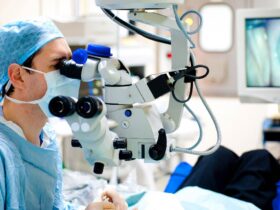Robotics are really changing the game for hair transplants. Think about it: machines can do some tasks with a steadiness that’s hard for even the steadiest human hand to match. This means more accuracy when taking out hair follicles and putting them in. It’s all about getting those tiny grafts just right.
The precision offered by robotics is a major step forward. This technology helps create a more natural look because the angle and depth of each implanted follicle can be controlled so precisely. It’s not just about getting more hair to grow; it’s about making it look like it was always there. This focus on detail is what separates good results from great ones.
Robotic systems can speed up the process, too. This means less time in the chair for patients, which is always a plus. Plus, because the procedures are less invasive, recovery is usually quicker. Patients often find they can get back to their normal routines faster, with less discomfort and fewer visible signs of the surgery.
Virtual Consultations and Remote Patient Monitoring
Expanding Access to Expert Opinions
Virtual consultations are changing how people get advice about hair transplants. Now, you don’t have to travel to see a specialist. You can connect with experienced doctors from your own home. This makes getting expert opinions much easier, especially if you live far from major cities. It’s a big step in making quality care more available to everyone. This technology really opens doors for people who might not have had the chance otherwise.
Streamlining Post-Operative Care
After a hair transplant, keeping an eye on how things are healing is important. Remote monitoring tools help doctors do just that. Using apps or special devices, they can check your progress without you needing to come back to the clinic all the time. This means they can spot any issues early and help you recover smoothly. It’s a way to get continuous support and guidance right after your procedure.
Convenient Patient Support from Anywhere
Technology makes staying in touch with your care team simple. Whether you’re at home or traveling, you can get the support you need. This convenience means less stress and more focus on healing. It’s all about making the patient experience better by being accessible. The goal is to provide helpful patient support no matter where you are.
Artificial Intelligence in Treatment Planning
Artificial intelligence (AI) is changing how hair transplant plans are made. It looks at lots of patient information to suggest the best way to do the transplant. This helps make sure the plan fits each person’s needs and what they want to achieve.
Personalized Treatment Recommendations
AI can look at your specific hair loss pattern, donor area quality, and even your hair type. Based on this, it can suggest the most effective treatment approach for you. This means getting a plan tailored just for you, not a one-size-fits-all solution. It helps pick the best techniques and number of grafts needed.
Optimizing Transplant Design and Precision
AI software helps design the actual transplant. It figures out the best placement for each follicle to look natural. This technology can map out the hairline and density with great accuracy. Using AI for planning means the final look is more predictable and pleasing.
Predicting Potential Complications for Better Outcomes
AI can also help spot possible problems before they happen. By analyzing data, it can flag risks like poor healing or unexpected results. This allows surgeons to adjust the plan to avoid these issues. This predictive power is a big step in making hair transplants safer and more successful.
Advanced Imaging for Accurate Diagnosis
High-Resolution Scalp Assessment
Getting a clear picture of your scalp is the first step. High-resolution imaging tools let doctors see your scalp in incredible detail. This helps them understand your hair loss pattern and the health of your donor area. It’s like having a super-powered magnifying glass for your scalp. This detailed view is key for planning any hair transplant procedure effectively.
3D Modeling for Surgical Strategy
Imagine seeing a 3D model of your head before surgery. Advanced imaging can create these models, showing exactly where hair can be transplanted. This allows surgeons to map out the best strategy, considering the natural flow of your existing hair. It helps them visualize the final result and make adjustments before the actual procedure even begins. This level of planning with 3D modeling is a big step forward.
Precise Follicle Identification and Planning
Identifying individual hair follicles accurately is critical. New imaging technologies help pinpoint healthy follicles for transplantation. This precision means better graft survival and more natural-looking results. The ability to identify and plan around these follicles using advanced imaging means less guesswork and more predictable outcomes for patients. It’s all about getting the right hair in the right place.
The Evolution of Hair Transplant Techniques
The journey of hair transplantation has seen a dramatic shift, moving from older methods to highly refined techniques that offer patients more natural and less invasive options. Early procedures, like the strip method (Follicular Unit Transplantation or FUT), involved removing a strip of scalp, which, while effective, often left a noticeable linear scar. This meant patients had to be careful about hairstyles to conceal the donor area.
Follicular Unit Extraction (FUE) has truly changed the game. This technique involves extracting individual hair follicles directly from the donor site. Because it doesn’t remove a strip of skin, FUE leaves behind only tiny, dot-like scars that are much easier to hide, even with very short haircuts. This makes FUE a preferred choice for many seeking a less visible donor scar.
From FUT to Follicular Unit Extraction (FUE)
The transition from FUT to FUE represents a significant leap forward in hair restoration. While FUT was the standard for years, its reliance on excising a strip of scalp meant a trade-off between graft yield and scarring. FUE, on the other hand, allows for the meticulous extraction of individual follicular units, minimizing trauma to the donor area and enabling a quicker return to normal activities. This shift prioritizes patient comfort and aesthetic outcomes.
Achieving Natural Hair Appearance
Modern techniques, especially FUE, are geared towards creating results that are virtually indistinguishable from natural hair growth. The precision in harvesting and implanting individual follicular units allows for the recreation of a natural hairline with appropriate density and angulation. This attention to detail ensures that the transplanted hair blends seamlessly with the existing hair, providing a fuller and more youthful appearance.
Understanding the UK hair clinic comparison tool
For patients in the UK, navigating the choices for hair restoration can be complex. Resources like a UK hair clinic comparison tool can be incredibly helpful. These tools often allow patients to compare clinics based on factors such as the techniques offered (like FUE vs. FUT), surgeon qualifications, patient reviews, and pricing. This transparency helps patients make more informed decisions about where to undergo their procedure, ensuring they find a clinic that aligns with their needs and expectations for natural-looking results.
Improving the Patient Experience Through Technology
Technology has really changed how people feel about getting a hair transplant. It’s not just about the results anymore; it’s about the whole journey. Things are quicker, less painful, and frankly, less scary than they used to be. Patients feel more in control and informed, which makes a big difference.
Reduced Procedure Times and Discomfort
Procedures used to take ages, and let’s be honest, they weren’t exactly a walk in the park. Now, with robotic assistance and more refined techniques, the actual time spent in the chair is often shorter. This means less time under anesthesia and less overall discomfort. Many patients report feeling much better during and after the procedure compared to older methods. It’s a big win for patient comfort.
Minimizing Scarring and Enhancing Aesthetics
One of the biggest worries for anyone considering a hair transplant is scarring. Technology has made huge strides here. Techniques like FUE, especially when aided by robotics, are incredibly precise. They allow for the harvesting and placement of individual follicles with minimal disruption to the scalp. This means less visible scarring, which is a major plus for aesthetics and patient confidence. The goal is natural-looking results that are hard to detect.
Increased Patient Satisfaction and Confidence
When you combine faster recovery, less discomfort, and better aesthetic outcomes, you naturally get happier patients. The ability to have virtual consultations also makes the process more accessible and less daunting. Patients feel more informed and supported throughout their journey. This improved patient experience directly translates to higher satisfaction and a boost in confidence once the results start to show. It’s technology making the whole process smoother and more positive.
Making the Choice Easier
It’s pretty clear that technology has really changed how people approach hair transplants. From robots doing the heavy lifting to virtual check-ins, the whole process feels more accessible and less daunting. Patients can get a clearer picture of what to expect, and the procedures themselves are getting better, faster, and more natural-looking. While the tech is impressive, remember that finding a good doctor who knows their stuff is still super important. They’ll guide you through it all, making sure you get the results you’re hoping for. So, if you’re thinking about it, know that the tools available today are making the decision and the journey a lot smoother.













